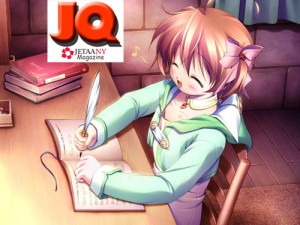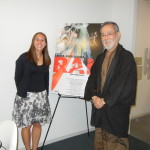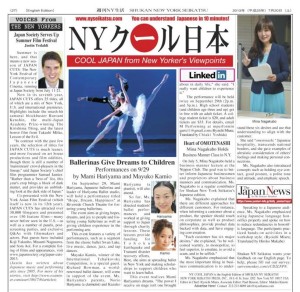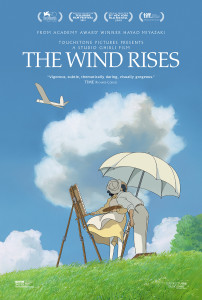
“The Wind Rises is a combination of everything that makes Studio Ghibli as we know it today. It also adds several new elements which make this film dynamic and, some say, controversial.” (Touchstone Pictures)
By Alexis Agliano Sanborn (Shimane-ken, 2009-11) for JQ magazine. Alexis is a graduate of Harvard University’s Regional Studies—East Asia (RSEA) program, and currently works as an executive assistant at Asia Society in New York City.
Written and directed by Hayao Miyazaki, The Wind Rises is like no Studio Ghibli movie I have ever seen. No. Wait. It’s like every Ghibli movie I have ever seen. You want fantasy? You got it. You want airships à la Castle in the Sky or Nausicaä of the Valley of the Wind? You got it. You want deliciously portrayed food? You want nostalgic scenery from bygone days of Tokyo or picturesque European towns? You got that, too. The Wind Rises is a combination of everything that makes Ghibli as we know it today. It also adds several new elements which make this film dynamic and, some say, controversial.
One of the most differentiating factors is that The Wind Rises is the only full-length feature to focus on an actual historical figure—Jiro Horikoshi, the designer of the Mitsubishi A5M, a fighter aircraft of World War II. Granted, Miyazaki used his artistic license to embellish the narrative—but he does that only to make things more beautiful and fantastical. (And that’s why we love Miyazaki, right?)
Watching The Wind Rises, you feel repeatedly—and indeed the entire plot more or less focuses on—Japan’s desperation to achieve modernity according to “Western standards.” But modernization was not a smooth road, and Miyazaki makes that message clear. Despite the beautiful veneer, the crux of this film lies in the frustration of a country and its people. Economic deflation, poverty, and limited resources repeatedly arise as roadblocks. (This may explain part of the reason for its amazing popularity in Japan. Frustrations, impatience and desperation exist within every generation.) Yet, as Jiro is reminded, even with setbacks and disappointments, one must live on and progress despite it all.
JQ Magazine: Australia Unfolds Its 17th Japanese Film Festival

The new Dragon Ball Z: Battle of Gods hits six cities in Australia as part of its 17th Japanese Film Festival continuing in October through December. (Dragon Ball Z Production Committee)
By Eden Law (Fukushima-ken, 2010-11). After the JET Programme more than fulfilled its promise of “an experience of a lifetime,” Eden returned to Sydney, Australia, where he joined the JETAA New South Wales chapter to take advantage of the network and connections available to undertake projects such as an uchiwa design competition for the Sydney Japan Festival. He also maintains the JETAANSW website and social media. Other than that, he’s a web designer and a poet, gentlemen and raconteur.
Like a springtime wave of hanami Down Under, the 17th Japanese Film Festival began showing in staggered releases nationally in Australia, blooming first in Broome in late September, before displaying a full bouquet of film delights in the major metropolitan areas of Sydney and Melbourne. This is the first time that the festival has launched a national program, ranging from a mini ensemble of three films for small towns like Broome and Cairns, to a behemoth 33 new films and five classics in major cities like Melbourne and Sydney, which means the festival will run from 17 Sep to 8 Dec as it tours around Australia. Many of the new films will be shown for the first time in Australia (aw, you spoil us, Japan Foundation, you really do!). In addition, at this time of writing, the five classics will be shown for free, allowing even the most penniless hipster to get a gander and drop a casual mention at the right fashionable dinner parties.
With so many new films, many of which aren’t known outside of Japan (trust me, I’ve Googled this), how will you know which to watch and be informed like the sophisticate that you no doubt are? Well, for a start, check out the screening schedules for all the films in your (nearest) city. But fret not, gentle reader, for I shall explore some of the selections on show.
Based on a True Story
Documentaries and dramatisations based on true stories feature strongly in this year’s program. A Boy Called H, which won Special Prize at the Moscow International Film Festival 2013, is based on Kappa Senoh’s best-selling autobiography about growing up in World War II-era Kobe. Closing some of the larger programs, Fruits of Faith is based on a novel inspired by a true story of a fruit grower who tries to achieve the impossible dream of the perfect crop of organic apples, despite skepticism and threat of bankruptcy. Reunion, based on a journalist’s accounts, is an illustration of how individuals strive to retain their humanity and compassion in the face of unrelenting misery and death in the wake of the Tohoku disaster. Leaving no eye dry at last year’s Montreal Film Festival, it’s a good way to see if life has yet to crush all feelings out of your bitter husk. And for anyone who has ever treasured a truly good bowl of ramen (especially after a long night of clubbing in Tokyo—the Japanese equivalent to our 4 a.m. kebab), the documentary The God of Ramen will inspire not just food lovers, but anyone who’s ever had an all-consuming (hah!) passion.
JQ Magazine Seeks Writers for Fall 2013!
As we head into fall, JETAA New York’s JQ magazine continues to provide content with an ever-expanding array of articles, interviews and features (see our recent stories here). We’re now looking for new writers, including recent returnees and JET vets, from all JETAA chapters worldwide for posting stories via our host at the global JET alumni resource site JETwit.com. (Scribes are also encouraged to join the JET Alumni Writers group on LinkedIn.)
Below are story ideas grouped by JET participants and alumni (JET World) and those more on Japanese culture (Japan World). And if you’re a JET or JETWit contributor from anywhere in the world with a story idea of your own, let us know!
Click “Read More” below for our fall 2013 ideas pitch package, and contact JQ editor Justin Tedaldi (magazine [at] jetaany [dot] org) to sign up for stories.
Now, JQ is looking for additional help behind the scenes! Our editor (celebrating his fifth anniversary at the helm in November) is seeking a capable assistant to help with the posting, social media sharing and story assigning across all JETAA chapters. If you’re a wiz with WordPress, Facebook and Twitter, and enjoy all forms of Japanese arts, events and media, reach out to Justin. Thanks and yoroshiku!
Justin’s Japan: Nippon in New York — Martial Arts, Hayao Miyazaki and ‘Evangelion’ at Comic Con
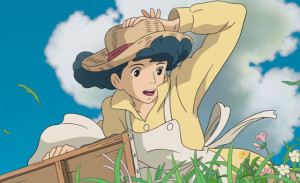
The Wind Rises, the latest film from director Hayao Miyazaki, has its U.S. premiere at New York’s Alice Tully Hall Sept. 28. (Studio Ghibli)
By JQ magazine editor Justin Tedaldi (CIR Kobe-shi, 2001-02) for Examiner.com. Visit his Japanese culture page here for related stories.
Saturday, Sept. 28, 3:00 p.m.
All American Open International Karate Championships
Hunter College Sportsplex, 68th Street and Lexington Avenue
$30 general admission/$65 RES floor/$80 VIP ringside
Get your kicks at this annual event presented by Kyokushin Karate New York, the original and world renowned full-contact knockdown karate style founded in 1953 by Grandmaster Mas Oyama. The All American Open consistently brings the world’s best karate fighters to compete for the amateur athletic championship title. Scheduled fighters Include 2012 All American Open champion Zahari Damyanov, Women’s World Middleweight champion Julie Lamarre, and Men’s World Heavyweight champion Alejandro Navarro.
Sept. 28 & Oct. 4
Alice Tully Hall, 1941 Broadway
$13
U.S. premiere! As part of the 51st New York Film Festival, the great Japanese animator Hayao Miyazaki’s new (and reportedly final) Studio Ghibli film is based on the life of Jiro Horikoshi, the man who designed the Zero fighter operated by the Imperial Japanese Navy from 1940 to 1945. An elliptical historical narrative, The Wind Rises is also a visionary cinematic poem about the fragility of humanity, starring the voice of Neon Genesis Evangelion director Hideaki Anno! Presented in Japanese with English subtitles.
Sept. 29, 5:00 p.m.
Rainbow Bubble Girls Open Audition as Talent Contest
Maid Cafe NY, 150 Centre Street
Free
Girl group Rainbow Bubble, an international all-girl idol group based in New York, is now looking for new members who can sing in different languages and dance. This current contest (which precludes semi-finals and finals to come) offers a top prize valued at $500 and a chance to receive an exclusive artist contract! Click here for contest rules and email StarGenerationsINC@gmail.com to pre-register.
For the complete story, click here.
JQ Magazine: DVD Review – ‘From Up on Poppy Hill’
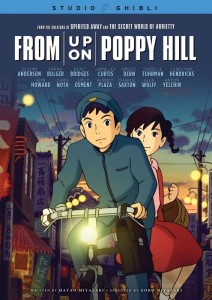
“Studio Ghibli films are known for their fantastical animation and surrealistic landscapes. However, Poppy Hill lacks one other crucial element common to Ghibili films: an emotional depth of feeling.” (GKIDS)
By Lyle Sylvander (Yokohama-shi, 2001-02) for JQ magazine. Lyle is entering a master’s program at the School of International and Public Affairs at Columbia University (MIA 2013) and has been writing for the JET Alumni Association since 2004. He is also the goalkeeper for FC Japan, a New York City-based soccer team.
From Up on Poppy Hill is the latest film to be released from Japan’s famed Studio Ghibli. Unlike its more prominent titles, this one is not directed by studio founder Hayao Miyazaki (Spirited Away, Howl’s Moving Castle) but rather by his son Goro Miyazaki. The father did, however, co-write the script (with Keiko Niwa), which was adapted from a manga published in the 1980s. Goro’s first film, Tales from Earthsea, was a commercial hit but received a very negative reception, even receiving “Worst Director” and “Worst Picture” designations from the Bunshun Raspberry Awards, given annually to the worst in cinema by the Bungeishunju Publishing Company. From Up on Poppy Hill received a much better reception (although many reviews were mixed) and became the highest grossing Japanese film of 2011 and won the 2012 Japan Academy Prize for Animation of the Year.
The story takes place in Yokohama in 1963, a pivotal point in Japan’s history as the country was preparing for the 1964 Tokyo Olympics. The nation was on the economic upswing and the Olympics were meant to showcase the “new” Japan as it pushed its postwar ruin firmly into the past. Within this context, Poppy Hill tells two stories, both of which deal with historical consciousness. The first concerns a high school student named Umi, who lives and works in her family’s boarding house. Her father was lost at sea during the Korean War and Umi flies nautical flags daily from her house in order to wish peace upon all sailors. The second story concerns a clubhouse (named the Latin Quarter), which has been slated for demolition to make way for an Olympics-related building. The building is adjacent to Umi’s high school and she meets Shun, the leader of the clubhouse, who also happens to have been decoding her nautical flags each morning. Umi leads an effort to clean up the clubhouse and soon starts to fall in love with Shun.
Justin’s Japan: Nippon in New York – Heritage at Citi Field, Hatsune Miku and the Joy of Sake

The Japanese Folk Dance Institute of New York will perform at Citi Field’s fourth annual Japanese Heritage Night Aug. 28. (Courtesy of blog.janm.org)
By JQ magazine editor Justin Tedaldi (CIR Kobe-shi, 2001-02) for Examiner.com. Visit his Japanese culture page here for related stories.
As the summer winds fade to fall colors, the weeks ahead are shaping up with these exciting events, ready to be enjoyed both before and after Labor Day.
This month’s highlights include:
Wednesday, Aug. 28, 6:30 p.m.
New York Mets Fourth Annual Japanese Heritage Night
Citi Field, 123-01 Roosevelt Ave.
$23 Promenade Reserved/$37 Pepsi Porch/$63 Baseline Box Silver
Watch the Mets take on the Philadelphia Phillies with a special Japanese Heritage Night pre-game show featuring the Japanese Folk Dance Institute of New York, the Japanese Men’s Choir, taiko and fue master Kaoru Watanabe, and the Spirit Award presentations to important members of the community. Look for fun Japanese activities and games throughout the evening at the special Japanese Heritage Night tables! A portion of the proceeds of all ticket sales made through the special JHN ticket window and through online sales will be given to the Japanese American Association’s Committee on Aging Issues.
Saturday, Aug. 31, 2:00 p.m.
Hatsune Miku Magical Mirai 2013 premiere
Anthology Film Archives, 32 Second Avenue
$20 general admission
In Japan, Hatsune Miku is a phenomenally successful virtual idol that grew out of fan-created songs. With a name meaning “first sound of the future,” she is based on an innovative singing synthesizer software character. This special theatrical release—her first in the U.S. in nearly two years—celebrates the pop Vocaloid’s sixth birthday of by capturing a special commemorative live concert at the Yokohama Area simulcast in both New York and Los Angeles. (For this Examiner’s review of Miku’s previous live film screening in Times Square, click here.)
Sunday, Sept. 1, 5:30 p.m.
J-Summit New York Benefit Concert
The Bowery Electric, 327 Bowery
$15 advance/$18 day of show
Offering a welcoming environment to enjoy music, dance, performance and fashion for all fans and artists, j-Summit New York has created a community focused on the connections and cultural exchanges between New York and Japan through electrifying events. Proceeds for this special benefit concert will contribute to the 2011 earthquake and tsunami relief fund. Bands for the night include Aki, Lust, Red, Iri, Nicole Oliva, Nafsi Groove, and Yuri Bear.
For the complete story, click here.
WIT Life #247: Takao Osawa bonanza!
WIT Life is a periodic series written by professional Writer/Interpreter/Translator Stacy Smith (Kumamoto-ken CIR, 2000-03). She starts her day by watching Fujisankei’s newscast in Japanese, and here she shares some of the interesting tidbits and trends along with her own observations.
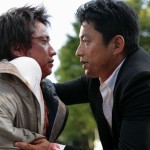
Two of Japan’s best current actors, Tatsuya Fujiwara and Takashi Osawa, in Takashi Miike’s Shield of Straw
I’m interpreting for a client in L.A. this week, and on the cross-country flight I had the chance to watch two interesting Japanese movies that were just released this year, making the long journey pass by much more quickly (Thank you Delta!). They both starred one of my favorite Japanese actors, the always かっこいい Takao Osawa. In this blog I have mentioned his appearances in other films, such as in 終の信託 (Tsui no Shintaku or A Terminal Trust) as the intimidating prosecutor. Osawa’s work never disappoints, and even though these particular movies were not necessarily of a genre I would usually opt to watch, he made sticking with them to the end worth it.
The first film was 藁の楯 (Wara no Tate or Shield of Straw), directed by the legendary Takashi Miike and based on the eponymous book by Kazuhiro Kiuchi. It features another one of my favorite performers, the fabulous Tatsuya Fujiwara who I recently highlighted from the film I’M FLASH! which debuted at this year’s Japan Society Japan Cuts film festival. Fujiwara plays a serial killer named Kiyomaru who targets young children, and Osawa is in the role of one of the Special Police assigned to safely escort him from Fukuoka to Tokyo (with Nanako Matsushima as his cracker jack partner). The grandfather of Kiyomaru’s most recent victim offers 1 billion yen to Read More
JQ Magazine: Film Review – ‘Cutie and the Boxer’ Pairs Sparring Partners in Life, Art
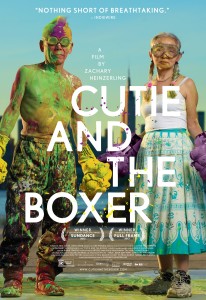
“Director Zachary Heinzerling spent five years with the Shinoharas in the making of his movie, and it has been recognized with critical praise and honors including the U.S. Documentary Directing Award at this year’s Sundance Film Festival.” (RADiUS-TWC)
By Stacy Smith (Kumamoto-ken CIR, 2000-03) for JQ magazine. Stacy is a professional Japanese writer/interpreter/translator. She starts her day by watching Fujisankei’s newscast in Japanese, and shares some of the interesting tidbits and trends together with her own observations in the periodic series WITLife.
Director Zachary Heinzerling’s debut documentary is the captivating Cutie and the Boxer, which follows two New York-based Japanese artists who have been married for over 40 years. It stars Ushio and Noriko Shinohara, a couple separated in age by two decades who have a truly unique union. They alternately bicker and support each other, but you get the sense that their respective existences are necessary for the other to survive. As wife Noriko puts it, “We are like two flowers in one pot,” meaning that when things are going well they are essential for each other’s flourishing, but when things are not they are fighting over limited space and nourishment.
Ushio (a.k.a. Gyu-chan) is an artist who was active in the avant-garde art movement, and is known for his boxing paintings and motorcycle sculptures. He achieved great fame in Tokyo before moving to New York to test his skills in the States. He was 40 at the time he met Noriko, who was 19 and had come to New York to study art. Things happened quickly between them, and soon they were married with a son, Alex. Noriko put aside her artistic aspirations to help Ushio in his career and raise Alex, thus curbing the potential for her own success.
Meanwhile, Ushio was floundering in building a name for himself as an artist in his new country. Despite the fact that he had become a father, he didn’t want to move beyond his old ways of drinking with friends and discussing philosophies regarding art. One of the most poignant and candid scenes in the film is when Ushio becomes quite drunk at one of these gatherings and emotionally describes both the pain and sublime pleasure he receives from creating art, saying that he would rather die than do anything else with this life. It is one of the film’s truly heartbreaking and inspiring moments.
Justin’s Japan: Nippon in New York — Karaoke Networking, Poisson Piano and ‘Cutie and the Boxer’
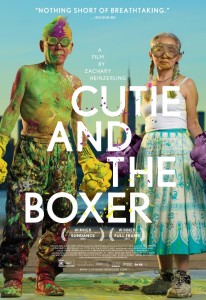
The award-winning documentary Cutie and the Boxer premieres at Lincoln Plaza Cinema and Landmark Sunshine Cinema Aug. 16. (RADiUS-TWC)
By JQ magazine editor Justin Tedaldi (CIR Kobe-shi, 2001-02) for Examiner.com. Visit his Japanese culture page here for related stories.
In the dog days of summer, it’s best to escape the heat in a place that’s cozy and cool. For those into Japanese cultural events, this month offers a diverse selection of music, film premieres and parties—all in the comfort of indoor air conditioning.
This month’s highlights include:
Thursday, Aug. 1, 7:30 p.m.
Young Professionals 2nd Annual Midsummer Matsuri and Karaoke Party
Japan Society, 333 East 47th Street
$10 for corporate and individual members, $15 for non-members
Japan Society’s Young Professionals events provide the opportunity for emerging business leaders from the U.S. and Japan (aged 25-45) to meet people with similar interests, experience programming on timely topics, and network with their peers. Attendees are invited to join for a night of networking, singing, eating and drinking featuring singer and Japanese TV personality Alex York as MC! Yukata and other summer attire are welcome, and admission includes light Japanese food and one drink ticket, cash bar thereafter. Space is limited; for advance registration email youngpro@japansociety.org or call 212-715-1219.
Saturday, Aug. 3, 7:00 p.m.
Asia Society, 725 Park Avenue
$35 members/students/seniors, $40 nonmembers
As part of the closing night presentation of the 36th Asian American International Film Festival, this screening of Our Homeland includes a Q&A with the director followed by an awards ceremony and gala reception featuring chef’s tasting tables and open bar with specialty cocktails sponsored by Rémy Martin. Sent decades ago as a child to North Korea under a repatriation program, Sungho returns to Japan for a temporary medical visit. A wrenching human drama unfolds as his family grapples with why he was ever let go. Under the constant surveillance by an accompanying North Korean official, Sungho and his family reunite again in this sensitive tale inspired by Korean-Japanese director Yang Yonghi’s true family story. Capturing the tender feelings of separation, memory, and belonging, the film also provides a rare glimpse into the life of ethnic Koreans in Japan. Presented in Japanese and Korean with English subtitles.
Friday, Aug. 16
Lincoln Plaza Cinema and Landmark Sunshine Cinema
$13, $13.50
Winner of the Directing Award for U.S. Documentary at the 2013 Sundance Film Festival and a hit at film festivals around the world, this candid New York story explores the chaotic 40-year marriage of renowned “boxing” painter Ushio Shinohara and his artist wife, Noriko. As a rowdy, confrontational young artist in Tokyo, Ushio seemed destined for fame, but met with little commercial success after he moved to New York City in 1969, seeking international recognition. When 19-year-old Noriko moved to New York to study art, she fell in love with Ushio—abandoning her education to become the wife and assistant to an unruly, husband. Over the course of their marriage, the roles have shifted. Now 80, Ushio struggles to establish his artistic legacy, while Noriko is at last being recognized for her own art—a series of drawings entitled “Cutie,” depicting her challenging past with Ushio. Spanning four decades, the film is a moving portrait of a couple wrestling with the eternal themes of sacrifice, disappointment and aging, against a background of lives dedicated to art.
For the complete story, click here.
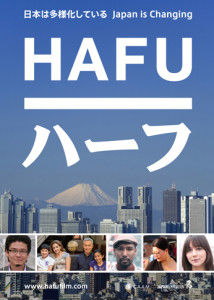
Hafu: The Mixed-Race Experience in Japan premieres in New York July 28. For more information, click here.
By Stacy Smith (Kumamoto-ken CIR, 2000-03) for JQ magazine. Stacy is a professional Japanese writer/interpreter/translator. She starts her day by watching Fujisankei’s newscast in Japanese, and shares some of the interesting tidbits and trends together with her own observations in the periodic series WITLife.
This weekend the annual Asian American International Film Festival will screen the new documentary Hafu: The Mixed-Race Experience in Japan (the title being the Romanization of “half” in Japanese), made by filmmakers Megumi Nishikura and Lara Perez Takagi and. Both half Japanese themselves, these women were inspired to undertake this project due to the lack of media attention on hafus and frustration with the shallow adoration of hafu celebrities on Japanese television.
The film begins with some informative statistics, such as that 2% of Japan’s population is foreign born and a striking 1 out of 49 babies is born to a family with a non-Japanese parent. These numbers have grown greatly over the last 30 years, and yet Japan is still lacking in its understanding of this diverse populace. Hafu features five half Japanese subjects, and their struggles and successes living in Japan today.
One of the families profiled is comprised of a Japanese father and a Mexican mother, who met while studying abroad in the U.S. They later married and now live in Nagoya with their two children. The older one, nine-year-old Alex, is having a hard time at his local school as the other kids tease him for being “English.” Alex’s parents believe that he needs a change in environment and decide to transfer him to an international school. He asks to spend some time in Mexico before the transition, and comes back from this trip brimming with confidence and an easing of the stutter that plagued him when he was being bullied (which his teachers had turned a blind eye to). Alex goes on to love his new school, make friends, and feel comfortable in his own skin without having to worry about being hafu.
JET alum helps produce “The Birth of Sake” documentary

Tara Hohenberger, who first fell in love with saké and the Japanese culinary world as an ALT in Nara (2001-2003) wrote to us about a film project she is helping produce. The documentary The Birth of Saké profiles the production seasons and lives of the workers at Tedorigawa, a fifth-generation, family-owned sake brewery in Ishikawa, Japan. Tedorigawa has been producing some of the world’s top award winning sakés since 1870 and still utilizes very traditional brewing methods.
Tara is working on the project with filmmaker Erik Shirai, who was a cinematographer on The Travel Channel’s No Reservations’ with Anthony Bourdain. The crew was first invited to the brewery in August of 2012 and was intrigued by the intense and relatively unknown process (even within Japan) of traditional saké making. Led by Brewmaster Teruyuki Yamamoto, the team of brewers is made up mostly of migrant farmers who grow rice in the summers and return to the brewery in late October to begin an intense six-month period of saké production. They will live under the same roof and eat three meals a day together. At the most intense time, when they brew the ultra-premium Daiginjyo variety they will barely have time to sleep.
 In January 2013, they returned to Ishikawa and were granted permission to spend several weeks living amongst the workers at the brewery. It allowed them a rare window into a cast of vibrant and dynamic characters and fueled their interest in painting a deeper portrait of the people behind the product. Shirai’s film captures this little understood world with his signature lush visual aesthetics in the stillness of winter in northern Japan.
In January 2013, they returned to Ishikawa and were granted permission to spend several weeks living amongst the workers at the brewery. It allowed them a rare window into a cast of vibrant and dynamic characters and fueled their interest in painting a deeper portrait of the people behind the product. Shirai’s film captures this little understood world with his signature lush visual aesthetics in the stillness of winter in northern Japan.
On July 9, they launched a Kickstarter campaign running through September 2, 2013, to complete the project. They hope to raise $50,000, which will allow a visit to film the Brewmaster in his hometown of Noto, Japan to illustrate the contrast of the intense life he leads inside the brewery for six months a year, with that of his land, his rice fields, his wife, children and his grandchildren. The film will also capture the critical moment when the workers return to the brewery to begin the production cycle again. Funding will also cover editing, musical composition, licensing, equipment rentals and other post-production costs.

You can view the trailer on The Birth of Saké’s Kickstarter page at
http://www.kickstarter.com/projects/1802764272/the-birth-of-sake
The filmmakers greatly appreciate your help in spreading the word about the film. Follow them at facebook.com/birthofsake + on Twitter: @iamwhatieatTV
WIT Life #242: End of Japan Cuts 2013
WIT Life is a periodic series written by professional Writer/Interpreter/Translator Stacy Smith (Kumamoto-ken CIR, 2000-03). She starts her day by watching Fujisankei’s newscast in Japanese, and here she shares some of the interesting tidbits and trends along with her own observations.
Yesterday Japan Cuts 2013 came to a successful close, with a jam-packed schedule of four films in a row. I only caught the middle two, Japan’s Tragedy and Dearest, both of which deal with the theme of death (like the earlier screened I’M FLASH, and they all do this deftly in their own unique ways). Japan’s Tragedy stars the amazing Tatsuya Nakadai, an 80-year old actor who I had the honor to interpret for at an event last month at the Museum of the Modern Image when his film Ran (directed by Akira Kurosawa) was featured and he participated in a Q&A following the film.
Nakadai’s downtrodden character in Japan’s Tragedy is in direct contrast to his genkiness in real life. The father he plays has recently lost his wife and has also been diagnosed with lung cancer on the morning of 3/11. After going through one operation he decides that he doesn’t want any more treatment, and furthermore that he will board himself up in his room and die beside the altar for his late wife. His son who is living with him since leaving his wife and daughter, as well as his job, is surviving on his father’s pension and taking care of him. Unsure of how to react to his father’s pronouncement, he initially tries to Read More
Justin’s Japan: Japan Society Serves Up Summer Film Festival
By JQ magazine editor Justin Tedaldi (CIR Kobe-shi, 2001-02) for Shukan NY Seikatsu. Visit his Examiner.com Japanese culture page here for related stories.
Summer’s here, and that means a new season of JAPAN CUTS: The New York Festival of Contemporary Japanese Cinema, running at Japan Society from July 11-21.
Now in its seventh year, JAPAN CUTS offers 25 titles, all of which are a mix of New York, U.S. and International premieres. Highlights include the smash-hit samurai blockbuster Rurouni Kenshin, the multi-Japan Academy Prize-winning The Kirishima Thing, and the latest horror film from Takashi Miike, Lesson of the Evil.
“In contrast with the past few years, the selection of titles for JAPAN CUTS is much leaner, and more focused on art house productions and film oddities, though there is still a number of ‘mainstream’ crowd-pleasers in the lineup,” says Japan Society’s chief film programmer Samuel Jamier. “Rather than a ‘best-of’ list, this year’s crop brings a block of dark matter, and provides an unblinking look at the dark side of Japan.”
Co-presented with the New York Asian Film Festival (which itself is now in its 12th year), JAPAN CUTS has attracted over 30,000 filmgoers and presented over 150 feature films—many never before seen in the U.S.—as well as a number of panels, post-screening parties, and exclusive Q&As with filmmakers and actors. Past guests have included Koji Yakusho, Masami Nagasawa, and Sora Aoi.
For a complete listing of films and appearances, visit www.japansociety.org/japan-cuts-2013.
WIT Life #241: The Ravine of Goodbye
WIT Life is a periodic series written by professional Writer/Interpreter/Translator Stacy Smith (Kumamoto-ken CIR, 2000-03). She starts her day by watching Fujisankei’s newscast in Japanese, and here she shares some of the interesting tidbits and trends along with her own observations.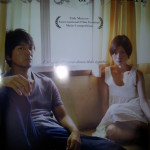
Last night’s Japan Cuts feature film was Tatsushi Omori’s The Ravine of Goodbye, which just received the Special Jury Prize at the Moscow International Film Festival. This movie is based on the book by Shuichi Yoshida (who also wrote the chilling Villain, later made into a 2010 movie), and depicts the life of a couple whose next door neighbor’s young son was found murdered. As the police begin their investigation and reporters start gathering facts for their stories, it becomes revealed that the husband was involved in a gruesome gang rape when he was a college student. As more information is found, the deeper layers are peeled back to reveal the truth of the incident’s aftermath.
There were several scenes that were left a bit vague and I had some unanswered questions while watching, though I have a hunch they could be cleared up by reading the original source material. I thought the movie was really engaging in the first half, but later on as the truth was being uncovered things seemed to slow down almost uncomfortably. I found Omori’s work reminiscent of the recent Sundance miniseries “Top of the Lake,” both theme and pacing wise. Although much of Ravine was disturbing, it is without a doubt a polarizing film that will lead to much discussion, as I heard many disparate reactions from viewers exiting the theater. And for that alone, perhaps it is worth seeing.
WIT Life #240: Japan Cuts 2013: Week 2
WIT Life is a periodic series written by professional Writer/Interpreter/Translator Stacy Smith (Kumamoto-ken CIR, 2000-03). She starts her day by watching Fujisankei’s newscast in Japanese, and here she shares some of the interesting tidbits and trends along with her own observations.
The amazing lineup at Japan Society’s Japan Cuts 2013 continues, and last night I had the chance to catch two films with the themes of loneliness and love. The first movie was I Have to Buy New Shoes, which is set in Paris and features a three-day romance between the main characters Aoi and Sen. The film’s title comes from their initial encounter, in which Aoi tripping over Sen’s passport causes the heel to come off her shoe and his passport to be ripped. She is a longtime resident of France, and he is visiting for the first time with his sister (who has abandoned him to find her boyfriend who is living there). Reminiscent of Celine and Jesse from Richard Linklater’s Before trilogy, Aoi and Sen fall into an easy rhythm as they find themselves spending all their moments together.
But with Sen’s departure three days away, there is a deadline to their relationship. Over this short period of time, they become close enough to confide in each other about Read More

